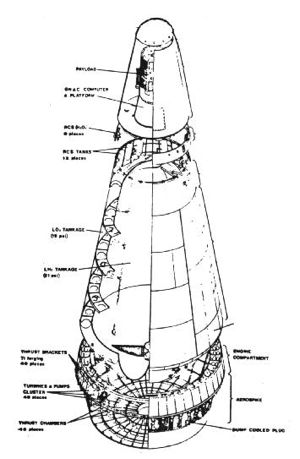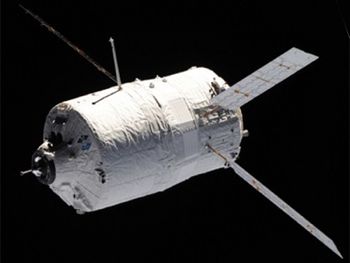
Home - Search - Browse - Alphabetic Index: 0- 1- 2- 3- 4- 5- 6- 7- 8- 9
A- B- C- D- E- F- G- H- I- J- K- L- M- N- O- P- Q- R- S- T- U- V- W- X- Y- Z
ATV
 ATV Credit: Gary Hudson |
AKA: Automated Transfer Vehicle;Jules Verne. Status: Operational 2008. First Launch: 2008-03-09. Last Launch: 2014-07-29. Number: 5 . Payload: 7,300 kg (16,000 lb). Gross mass: 19,357 kg (42,674 lb). Unfuelled mass: 16,494 kg (36,363 lb). Height: 10.27 m (33.69 ft). Diameter: 4.48 m (14.69 ft). Span: 22.30 m (73.10 ft).
Later the design was based on use of an Ariane 5 to launch the ATV for docking with the International Space Station. Following protracted development, the ATV finally flew in 2008.
Early studies focused on a modified version of the Ariane-5's L9.7 upper stage -- the 'ARIES' concept -- but by 1992 the European Space Agency had decided a custom-built propulsion module would be more efficient. A pressurized or unpressurised Cargo Carrier module would transport up to 9000 kg of supplies.
The European Space Agency also considered using the Ariane-5/ATV to launch the Columbus laboratory. The project's detailed Phase B2 began in July 1996. By 1997, ESA had decided to use solar panels to produce additional power for the Automated Transfer Vehicle. One mission of the Automated Transfer Vehicle would be to boost the International Space Station's orbit. Occasional propulsive maneuvers would be necessary to keep the ISS orbit from decaying, since air drag slowly lowered the Space Station's orbit. The ATV would dock at the rear of the Russian Service Module and the Russian Space Agency was providing a rendezvous and docking system as part of an ESA/RSA deal. Periodically boosting the ISS orbit now increasingly appeared to be the ATV's most important mission, since the Russians might not be able to launch enough Progress cargo spacecraft to do the job and the shuttle would eventually retire.
ESA signed a $470 million contract with Aerospatiale in 1998 to develop the Automated Transfer Vehicle. The European Space Agency also paid $23 million to RSA and NPO Energia for integrating the ATV into the ISS Service Module, while the French space agency CNES received $30 million to develop interfaces for the ATV's Ariane-5 carrier rocket. Aerospatiale also signed a consortium agreement with Daimler Chrysler Aerospace, who were to produce up to a dozen ATVs between 2003 and 2013. The target price was $70 million per ATV plus $115 million for the Ariane-5 booster. The final ATV version had a dry mass of 9.2t (including its 3,694kg MPLM-derived Cargo Carrier); carried 2.68-6.76t of propellant for ISS rendezvous and reboost; and the maximum weight at launch was about 20.5t. The spacecraft could carry up to 7 metric tons of cargo in eight International Standard Payload Racks, including 860kg of propellant, 840kg of water and 100kg of atmospheric gases.
In 2005 Lockheed Martin and EADS Space Transportation joined forces to sell the Automated Transfer Vehicle (ATV) to NASA for ISS resupply. The first ATV was then expected to launch in May 2007. Further delays pushed this into 2008. While the ATV would certainly be launched on the Ariane 5 rocket for European missions, it could potentially be launched by Lockheed's Atlas 5 if contracted by NASA.
Orbital Storage: 360 days. Habitable Volume: 48.00 m3.
More at: ATV.
| ATV ICC European space tug. Study 1985. The Integrated Cargo Carrier was located at the forward end of the ATV. It represented 60% of the total ATV volume and carried all of the cargo for resupplying the Station. |
| ATV SM European space tug. Study 1985. The unpressurized ATV Service Module included propulsion systems, electrical power (including solar arrays), computers, communications and most of the avionics. |
Family: Space Tugs. Country: Europe. Engines: R-4D. Launch Vehicles: Detko ATV, Ariane 5, Ariane 5G, Ariane 5GS, Ariane 5ES. Launch Sites: Kourou, Kourou ELA3. Agency: ESA, Cannes. Bibliography: 10817, 12126.
 | ATV-1 Jules Verne Credit: Manufacturer Image |
2008 March 9 - . 04:03 GMT - . Launch Site: Kourou. Launch Complex: Kourou ELA3. LV Family: Ariane 5. Launch Vehicle: Ariane 5ES.
- ATV-1 Jules Verne - .
Mass: 19,012 kg (41,914 lb). Nation: France.
Agency: Arianespace.
Program: ISS.
Class: Manned.
Type: Manned logistics spacecraft. Spacecraft: ATV.
Duration: 204.39 days. Decay Date: 2008-09-29 . USAF Sat Cat: 32686 . COSPAR: 2008-008A. Apogee: 343 km (213 mi). Perigee: 336 km (208 mi). Inclination: 51.60 deg. Period: 91.30 min.
First launch of Europe's Automated Transfer Vehicle, a logistics vehicle designed for ISS resupply. The Ariane model 5ES launch vehicle, vehicle L528, had the enhanced EAP solid boosters and EPC core stage of the Ariane 5ECA, but with the new EPS-V upper stage with restart capability and a vehicle equipment bay instrument unit strengthened to carry the heavier LEO payload. Jules Verne carried 1300 kg of dry cargo, 302 kg of water and oxygen, and 860 kg of propellant to the ISS. For this test mission it had a dry mass of 10075 kg and 6475 kg of maneuvering propellant (in later missions the propellant could be thousands of kilograms less, in order to deliver more cargo).
The EPS stage made its first burn and placed the stack into a 137 km x 260 km orbit at 04:20 GMT. The EPS restarted at 05:05, burned for 30-seconds, and released the ATV into a 254 km x 272 km orbit.
Following extensive checkouts and maneuvering near the ISS, ATV Jules Verne docked at the aft end of ISS Zvezda module at 14:52 GMT on 3 April. While docked to the station, it was used several times to boost the station's orbit and to shift it in debris avoidance maneuvers. The ATV undocked from the ISS on 5 September and used a fuel-conserving 23 days to position itself for a safe re-entry over the South Pacific. Final destructive re-entry began at 13:30 GMT on 29 September.
2011 February 16 - . 21:51 GMT - . Launch Site: Kourou. Launch Complex: Kourou ELA3. LV Family: Ariane 5. Launch Vehicle: Ariane 5ES.
- ATV-2 Johannes Kepler - . Mass: 19,712 kg (43,457 lb). Nation: Europe. Program: ISS. Class: Manned. Type: Manned logistics spacecraft. Flight: Soyuz TMA-01M, Soyuz TMA-20. Spacecraft: ATV. Duration: 125.00 days. Decay Date: 2011-06-21 . USAF Sat Cat: 37368 . COSPAR: 2011-007A. Apogee: 347 km (215 mi). Perigee: 343 km (213 mi). Inclination: 51.60 deg. Period: 91.40 min. ISS resupply; second European Space Agency Automated Transfer Vehicle. Docked with the ISS Zvezda module on 25 February. Undocked on 21 June at 14:46 GMT. Retrofire the same day at 20:04 GMT sent it to burn up over the Pacific Ocean..
2012 March 23 - . 04:34 GMT - . Launch Site: Kourou. Launch Complex: Kourou ELA3. LV Family: Ariane 5. Launch Vehicle: Ariane 5ES.
- ATV-3 Edoardo Amaldi - .
Mass: 19,714 kg (43,461 lb). Nation: Europe.
Program: ISS.
Class: Manned.
Type: Manned logistics spacecraft. Spacecraft: ATV.
Duration: 194.00 days. Decay Date: 2012-10-03 . USAF Sat Cat: 38096 . COSPAR: 2012-010A. Apogee: 406 km (252 mi). Perigee: 392 km (243 mi). Inclination: 51.60 deg. Period: 92.50 min.
European cargo station resupply spacecraft. Docked at the aft Zvezda port of the International Space Station on 28 March at 22:31 GMT. Its engines were used on 31 March and 5 April to reboost the ISS to a 387 km x 398 km orbit. Undocked at 21:44 GMT on 28 September and was deorbited over the Pacific at 23:42 GMT on 2 October, with loss of signal at 01:25 GMT on 3 October.
2013 June 5 - . 21:52 GMT - . Launch Site: Kourou. Launch Complex: Kourou ELA3. LV Family: Ariane 5. Launch Vehicle: Ariane 5ES.
- ATV-4 Albert Einstein - . Mass: 19,870 kg (43,800 lb). Nation: Europe. Program: ISS. Class: Manned. Type: Manned logistics spacecraft. Spacecraft: ATV. Duration: 150.00 days. Decay Date: 2013-11-02 . USAF Sat Cat: 39175 . COSPAR: 2013-027A. Apogee: 421 km (261 mi). Perigee: 409 km (254 mi). Inclination: 51.65 deg. Period: 92.88 min. Delivered supplies to the ISS. Deorbited over the Pacific on 2 November 2013 at 11:28 GMT, entry loss of signal was at 12:04 GMT..
2014 July 29 - . 23:47 GMT - . Launch Site: Kourou. Launch Complex: Kourou ELA3. LV Family: Ariane 5. Launch Vehicle: Ariane 5ES.
- ATV-5 Georges Lemaitre - . Mass: 19,520 kg (43,030 lb). Nation: France. Agency: AE. Spacecraft: ATV. Duration: 201.00 days. Decay Date: 2015-02-15 . USAF Sat Cat: 40103 . COSPAR: 2014-044A. Apogee: 419 km (260 mi). Perigee: 413 km (256 mi). Inclination: 51.65 deg. Period: 92.89 min. ISS resupply mission. Arrived at the ISS on August 12, docking with Zvezda at 13:30 GMT. Undocked from the ISS Zvezda module at 13:42 GMT on February 14 2015 and was deorbited over the Pacific on February 15..
Back to top of page
Home - Search - Browse - Alphabetic Index: 0- 1- 2- 3- 4- 5- 6- 7- 8- 9
A- B- C- D- E- F- G- H- I- J- K- L- M- N- O- P- Q- R- S- T- U- V- W- X- Y- Z
© 1997-2019 Mark Wade - Contact
© / Conditions for Use